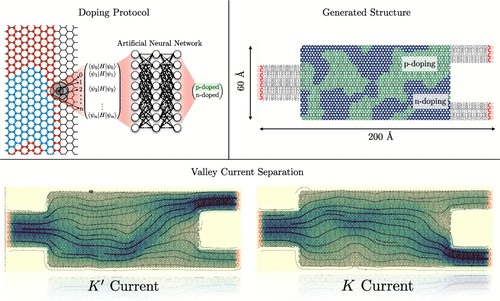当前位置:
X-MOL 学术
›
J. Phys. Chem. C
›
论文详情
Our official English website, www.x-mol.net, welcomes your feedback! (Note: you will need to create a separate account there.)
Inverse Design of a Graphene-Based Quantum Transducer via Neuroevolution
The Journal of Physical Chemistry C ( IF 3.7 ) Pub Date : 2020-11-18 , DOI: 10.1021/acs.jpcc.0c06903 Kevin Ryczko 1, 2 , Pierre Darancet 3, 4 , Isaac Tamblyn 1, 2, 5
The Journal of Physical Chemistry C ( IF 3.7 ) Pub Date : 2020-11-18 , DOI: 10.1021/acs.jpcc.0c06903 Kevin Ryczko 1, 2 , Pierre Darancet 3, 4 , Isaac Tamblyn 1, 2, 5
Affiliation

|
We introduce an inverse design framework based on artificial neural networks, genetic algorithms, and tight-binding calculations, capable to optimize the very large configuration space of nanoelectronic devices. Our non-linear optimization procedure operates on trial Hamiltonians through superoperators controlling growth policies of regions of distinct doping. We demonstrate that our algorithm optimizes the doping of graphene-based three-terminal devices for valleytronics applications, monotonously converging to synthesizable devices with high merit functions in a few thousand evaluations (out of ≃23800 possible configurations). The best-performing device allowed for a terminal-specific separation of valley currents with ≃96% (≃94%) K(K′) valley purity. Importantly, the devices found through our non-linear optimization procedure have both a higher merit function and higher robustness to defects than the ones obtained through geometry optimization.
中文翻译:

基于神经进化的基于石墨烯的量子传感器的逆设计
我们介绍了一种基于人工神经网络,遗传算法和紧密绑定计算的逆设计框架,能够优化纳米电子设备的超大配置空间。我们的非线性优化程序通过控制超级操作员对不同掺杂区域的生长策略的超级算子对哈密顿量进行运算。我们证明了我们的算法针对谷电子产品优化了基于石墨烯的三端器件的掺杂,并在数千次评估中(单价2 3800种可能)单调收敛到具有高品质功能的可合成器件。最佳性能的设备允许终端特定的谷值电流分离,K96%(≃94%)K(K′)谷纯度。重要的是,与通过几何优化获得的器件相比,通过我们的非线性优化程序发现的器件具有更高的优点函数和更高的抗缺陷能力。
更新日期:2020-12-03
中文翻译:

基于神经进化的基于石墨烯的量子传感器的逆设计
我们介绍了一种基于人工神经网络,遗传算法和紧密绑定计算的逆设计框架,能够优化纳米电子设备的超大配置空间。我们的非线性优化程序通过控制超级操作员对不同掺杂区域的生长策略的超级算子对哈密顿量进行运算。我们证明了我们的算法针对谷电子产品优化了基于石墨烯的三端器件的掺杂,并在数千次评估中(单价2 3800种可能)单调收敛到具有高品质功能的可合成器件。最佳性能的设备允许终端特定的谷值电流分离,K96%(≃94%)K(K′)谷纯度。重要的是,与通过几何优化获得的器件相比,通过我们的非线性优化程序发现的器件具有更高的优点函数和更高的抗缺陷能力。


























 京公网安备 11010802027423号
京公网安备 11010802027423号